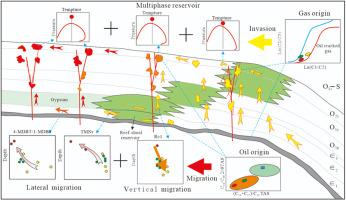碳酸盐岩台地边缘深层多相油气成因的地球化学证据——以塔里木盆地玉克地区奥陶系石油为例
IF 4.1
3区 地球科学
Q2 GEOSCIENCES, MULTIDISCIPLINARY
引用次数: 0
摘要
高成熟轻质油储层的成因机制一直是深部油气勘探研究的热点问题。为了更好地考察塔里木盆地奥陶系碳酸盐岩台地边缘多相油气藏的发育情况,本研究应用了有机地球化学技术。通过对奥陶系原油轻烃组分和三芳基甾烷参数的分析,确定奥陶系原油产自成熟至高成熟阶段,主要来源于下寒武统雨尔图斯组。此次研究的一个重要发现是原油的芳烃参数逐渐增加,包括甲基二苯并噻吩(4-MDBT/1-MDBT)和三甲基萘指数(TMNr),表明了碳酸盐岩台地边缘的油气有两条流体运移路线——垂直和侧向。这些发现为研究深部多期差异性油气成藏机理提供了新的思路。膏盐岩的不连续分布和走滑断裂的活动控制了晚期天然气的侵入强度,是形成多期油气富集的关键因素。研究点底部中寒武统石膏盖层的不连续存在导致晚期天然气侵入显著增加。垂直走滑断裂带和横向输运系统对碳酸盐岩台地边缘油气的空间分布起着至关重要的作用。原油芳烃参数对判别高成熟油气成因特征具有重要意义。本文章由计算机程序翻译,如有差异,请以英文原文为准。

Geochemical evidence for the origin of multiphase hydrocarbons in the deep carbonate platform margin: examples of Ordovician oil in the Yuke of the Tarim basin
The genetic mechanism of high-maturity light oil reservoirs has long been an issue in deep oil and gas exploration. In order to better examine the development of multiphase hydrocarbon reservoirs on the edge of the Ordovician carbonate platform in the Yuke Tarim Basin, this research used the application of organic geochemistry techniques. An analysis of the light hydrocarbon components and triarylsterane parameters of the Ordovician oil confirmed that the oil was produced from the mature to highly mature stage and was sourced primarily from the lower Cambrian Yuertusi Formation. A significant discovery from this investigation is the gradual increase in aromatic parameters of crude oil, including methyl dibenzothiophene (4-MDBT/1-MDBT) and the trimethylnaphthalene index (TMNr), indicating two fluid migration routes—vertical and lateral—for hydrocarbons within the carbonate platform margin. These findings provide a new insight into the underlying mechanism of deep multistage differential hydrocarbon accumulation. The discontinuous distribution of gypsum and salt rocks and the activity of strike-slip faults control the intensity of late-stage natural gas intrusion, which is a key factor in the formation of multi-phase oil and gas enrichment.The discontinuous presence of the middle Cambrian gypsum cap at the base of the study site resulted in a notable increase in late gas invasion. The vertical strike-slip fault zone and transverse transport system play crucial roles in the spatial distribution of hydrocarbons at the carbonate platform margin. Additionally, the analysis underscores the significant value of aromatic parameters of crude oil in identifying the genetic characteristics of highly mature oil and gas.
求助全文
通过发布文献求助,成功后即可免费获取论文全文。
去求助
来源期刊

Physics and Chemistry of the Earth
地学-地球科学综合
CiteScore
5.40
自引率
2.70%
发文量
176
审稿时长
31.6 weeks
期刊介绍:
Physics and Chemistry of the Earth is an international interdisciplinary journal for the rapid publication of collections of refereed communications in separate thematic issues, either stemming from scientific meetings, or, especially compiled for the occasion. There is no restriction on the length of articles published in the journal. Physics and Chemistry of the Earth incorporates the separate Parts A, B and C which existed until the end of 2001.
Please note: the Editors are unable to consider submissions that are not invited or linked to a thematic issue. Please do not submit unsolicited papers.
The journal covers the following subject areas:
-Solid Earth and Geodesy:
(geology, geochemistry, tectonophysics, seismology, volcanology, palaeomagnetism and rock magnetism, electromagnetism and potential fields, marine and environmental geosciences as well as geodesy).
-Hydrology, Oceans and Atmosphere:
(hydrology and water resources research, engineering and management, oceanography and oceanic chemistry, shelf, sea, lake and river sciences, meteorology and atmospheric sciences incl. chemistry as well as climatology and glaciology).
-Solar-Terrestrial and Planetary Science:
(solar, heliospheric and solar-planetary sciences, geology, geophysics and atmospheric sciences of planets, satellites and small bodies as well as cosmochemistry and exobiology).
 求助内容:
求助内容: 应助结果提醒方式:
应助结果提醒方式:


